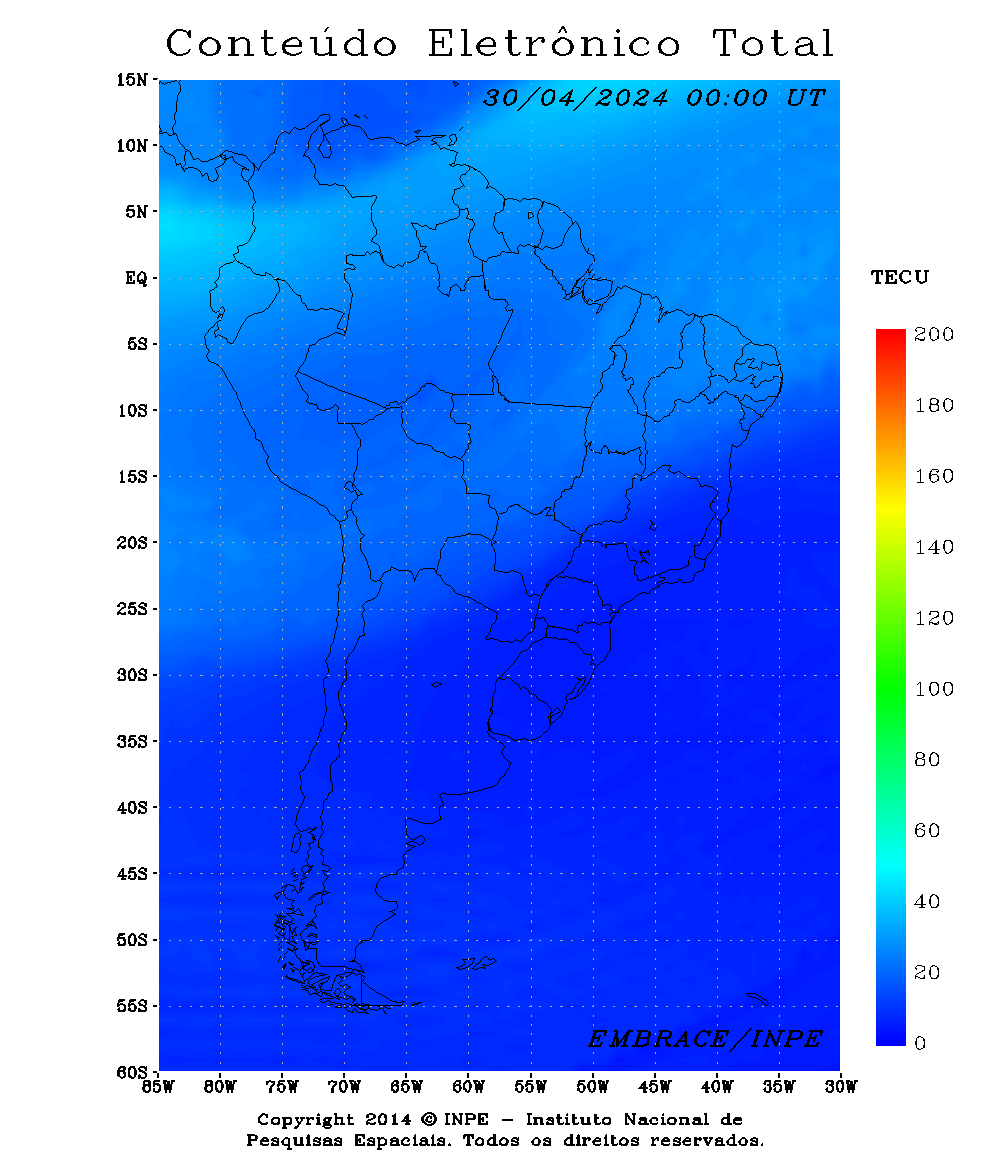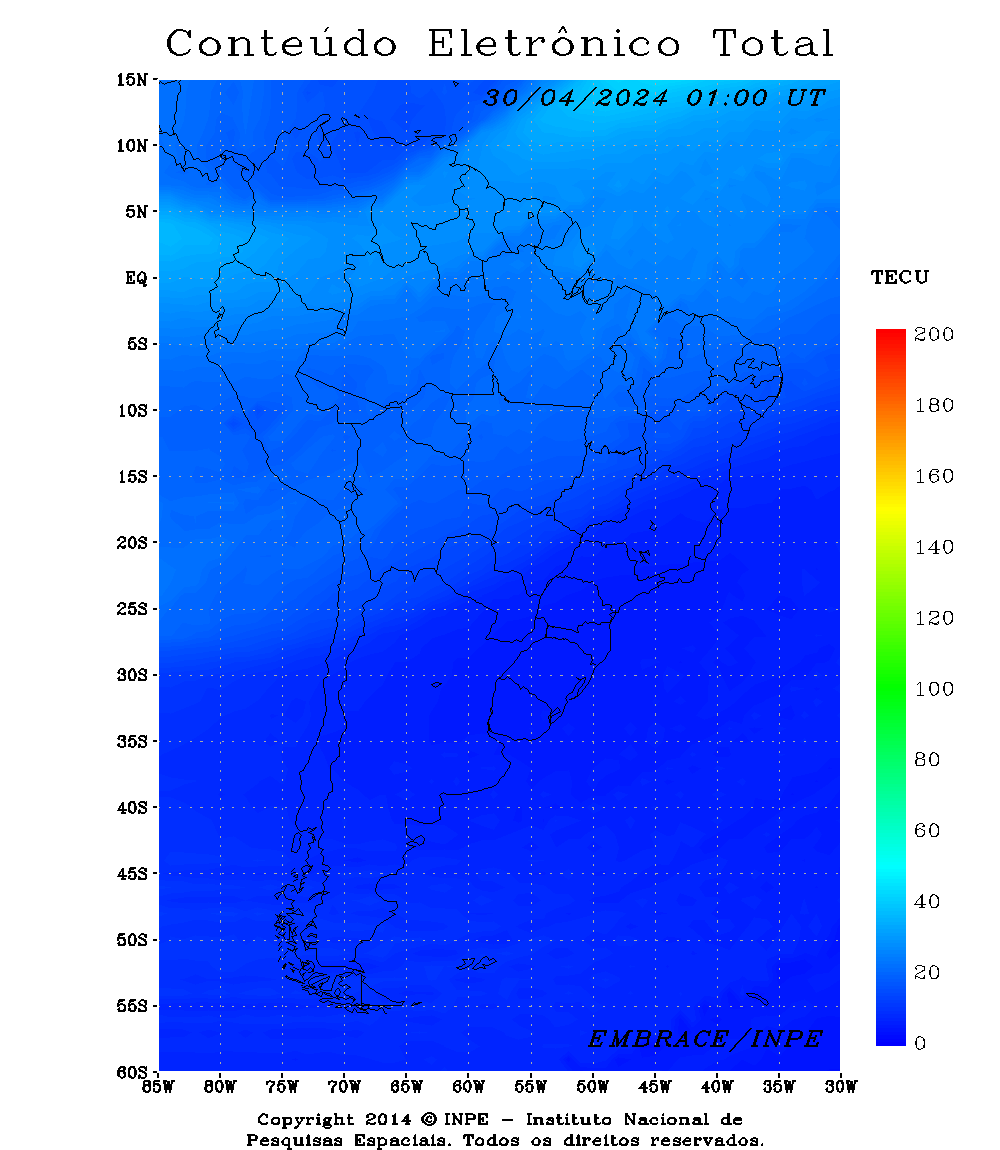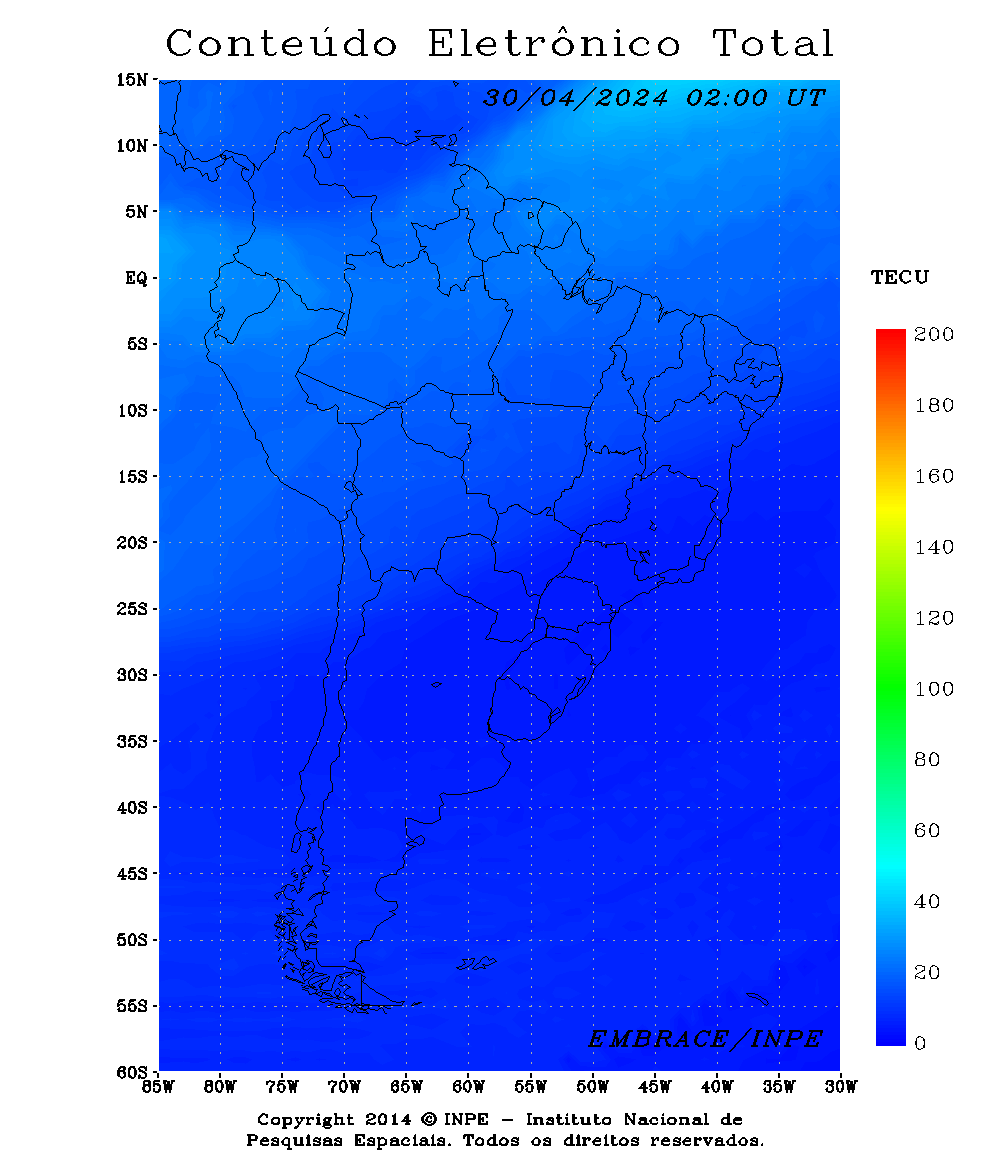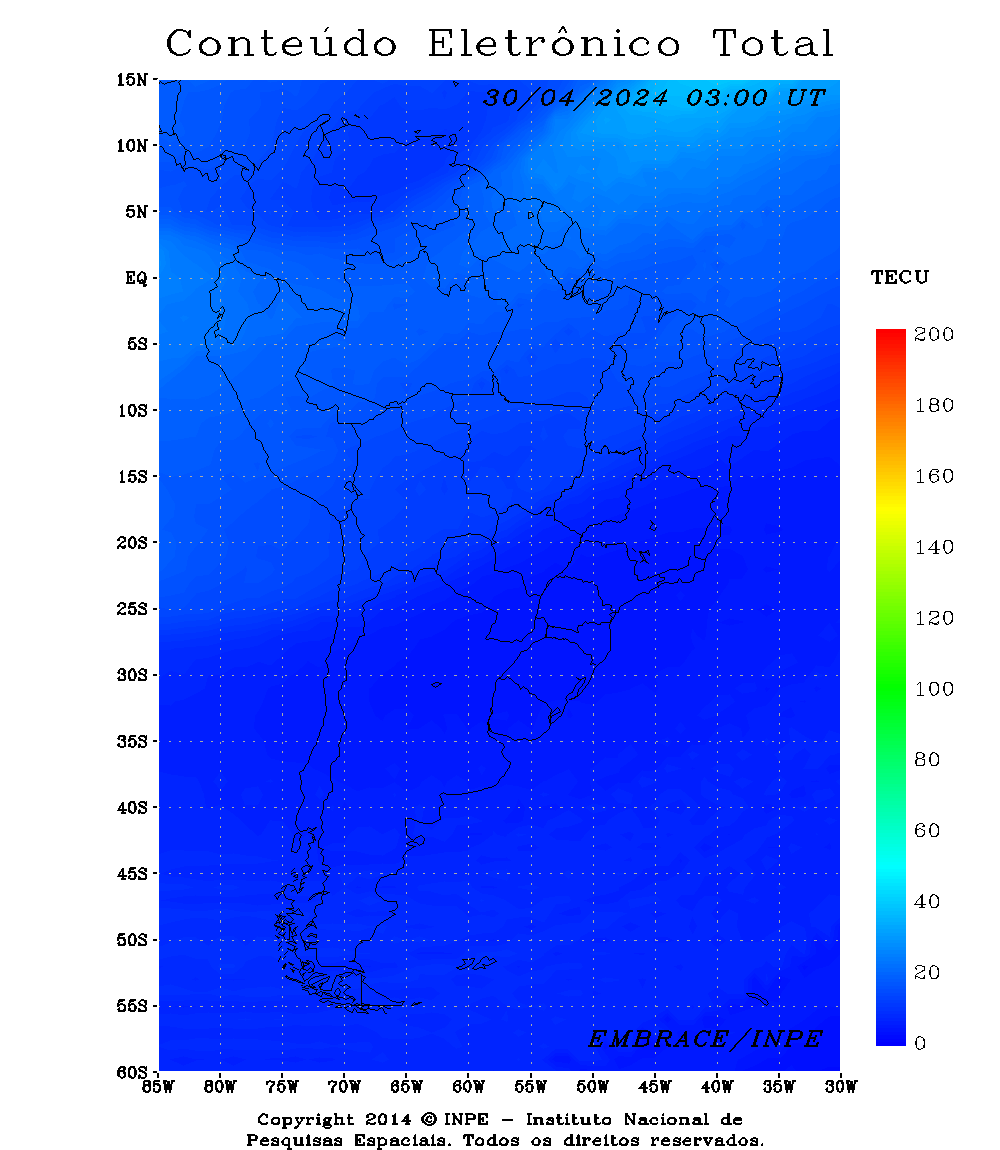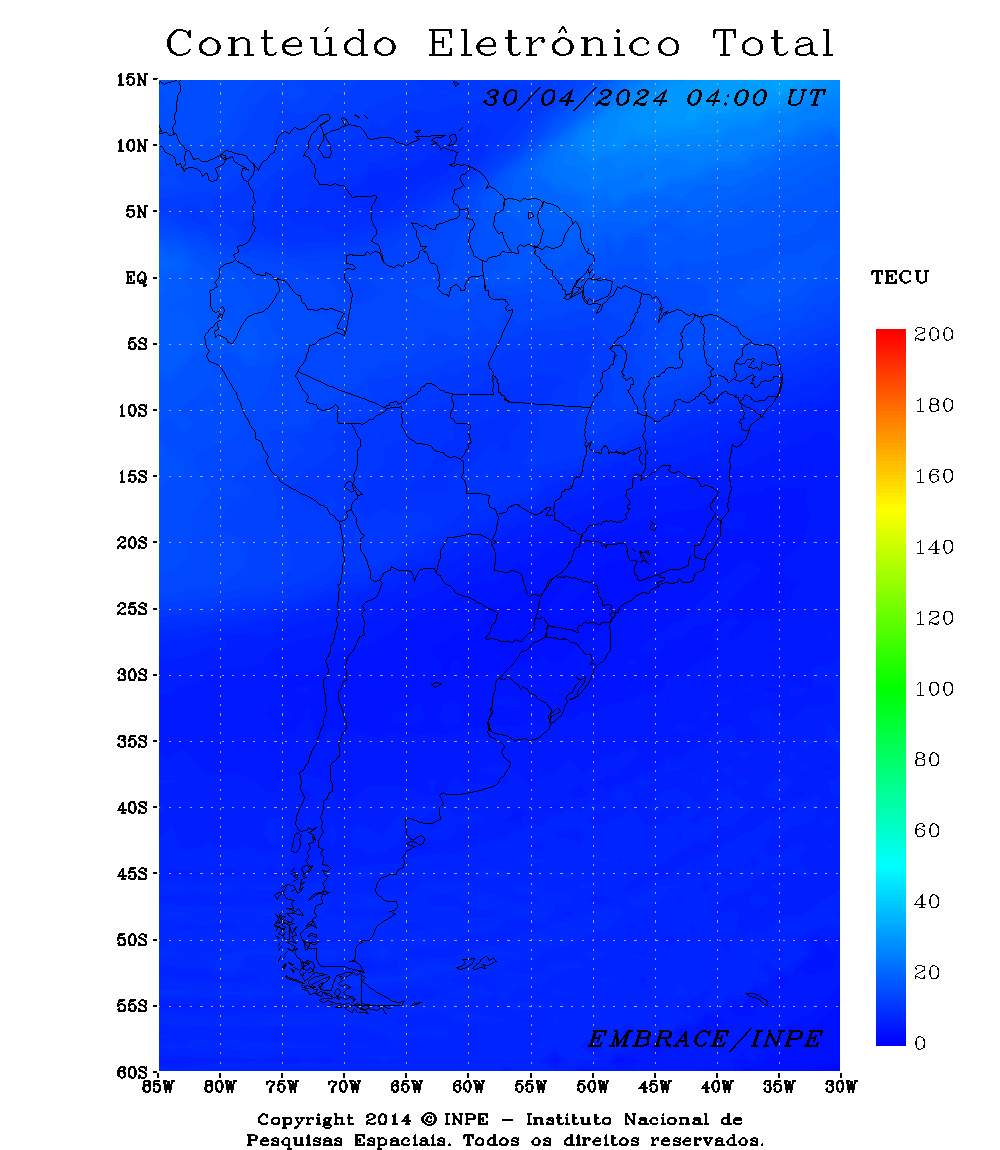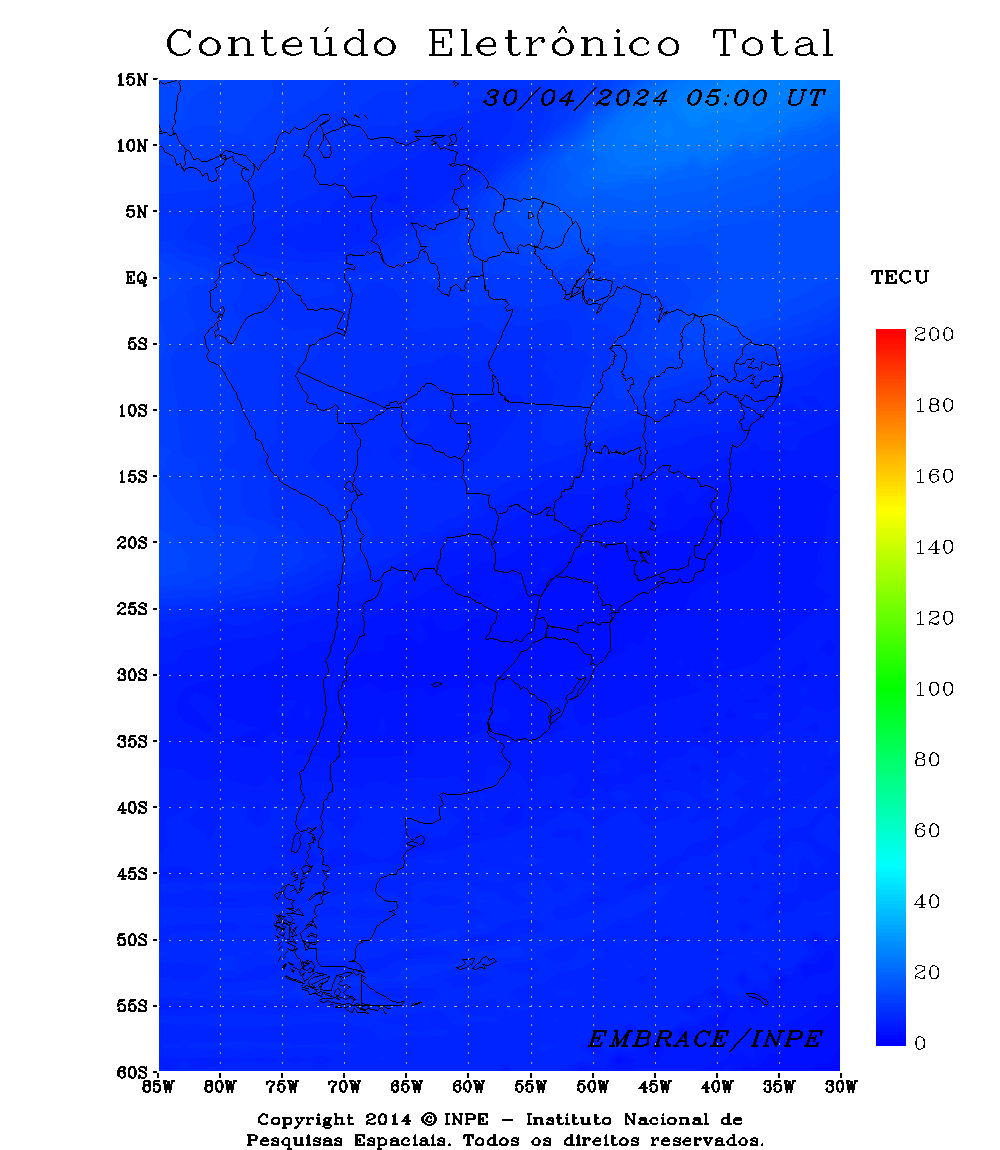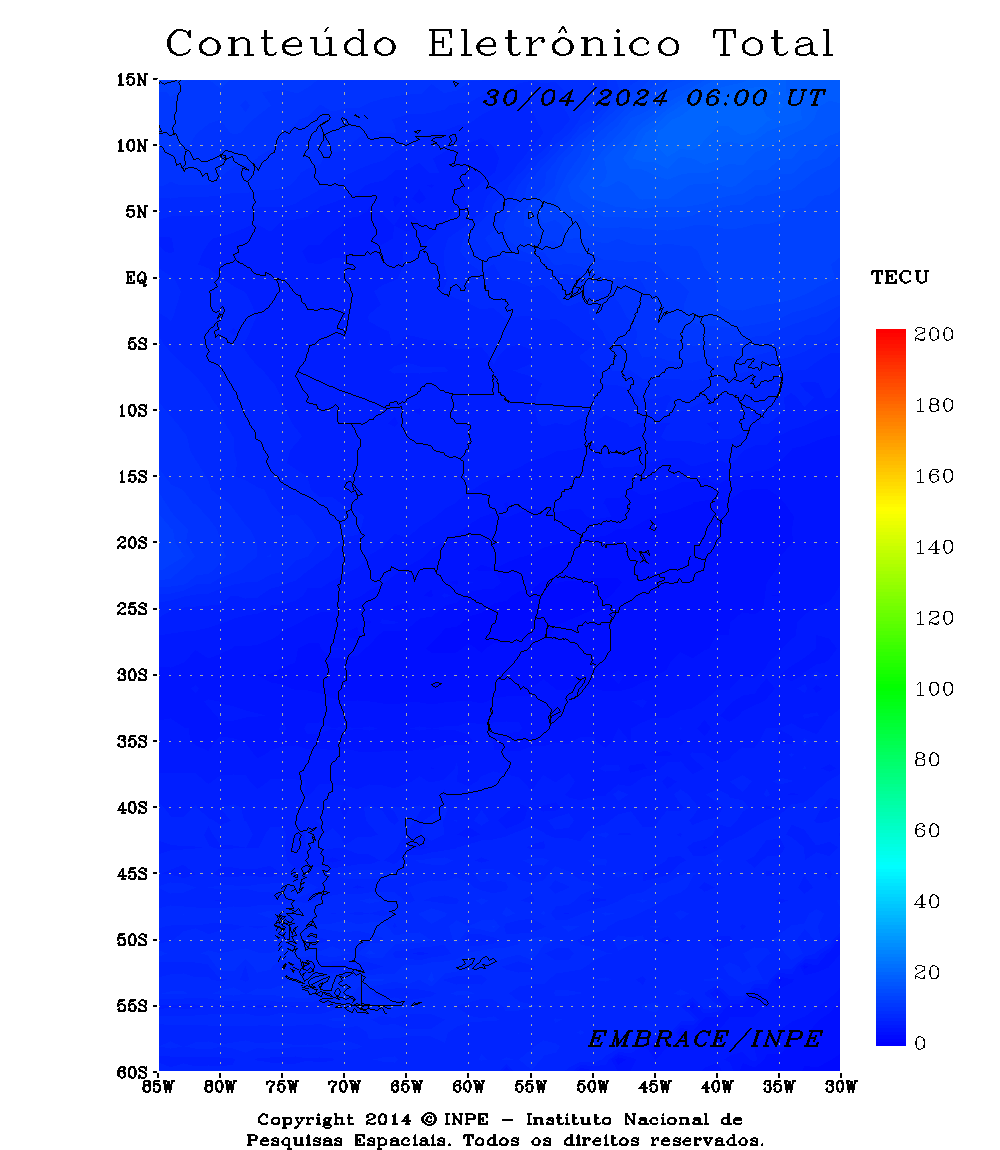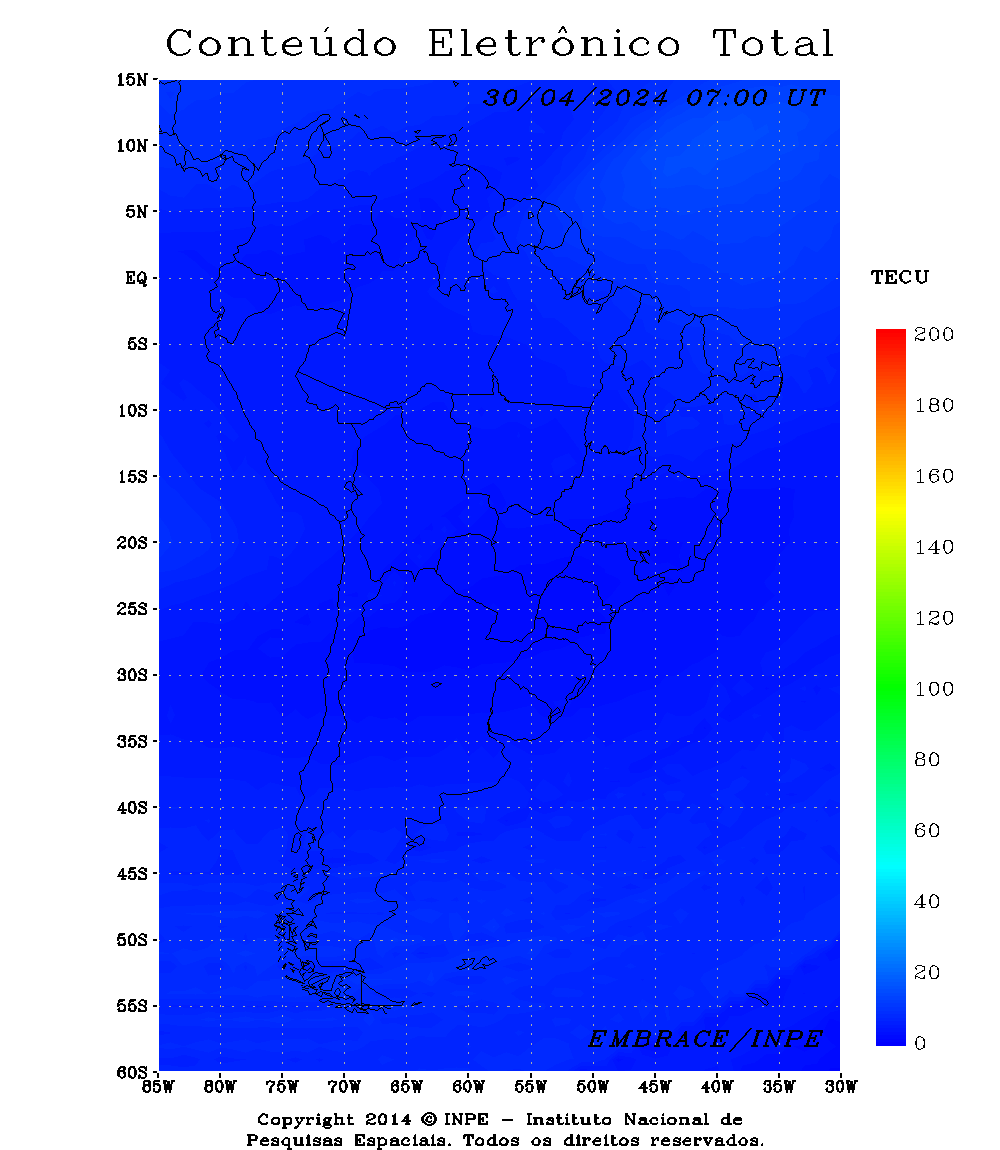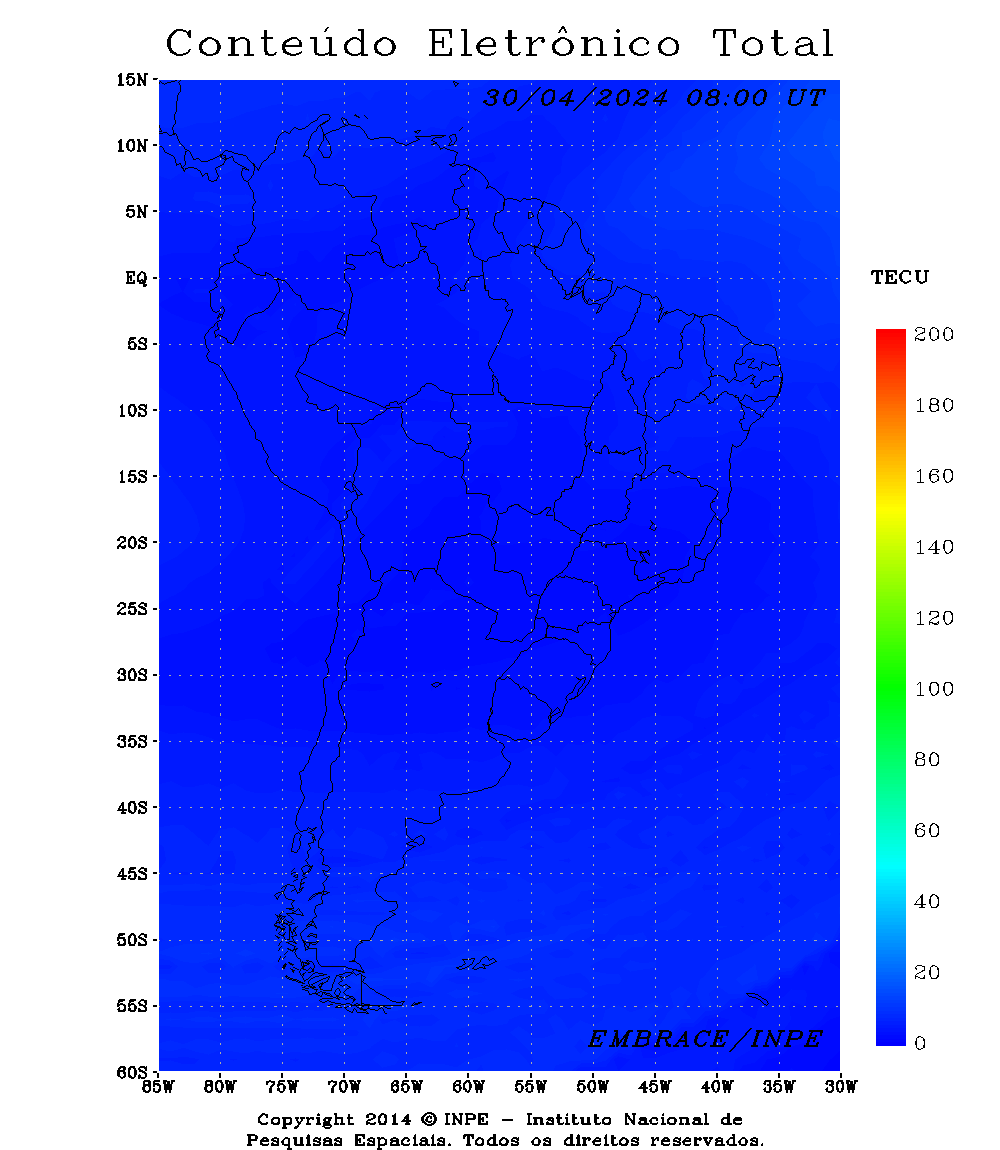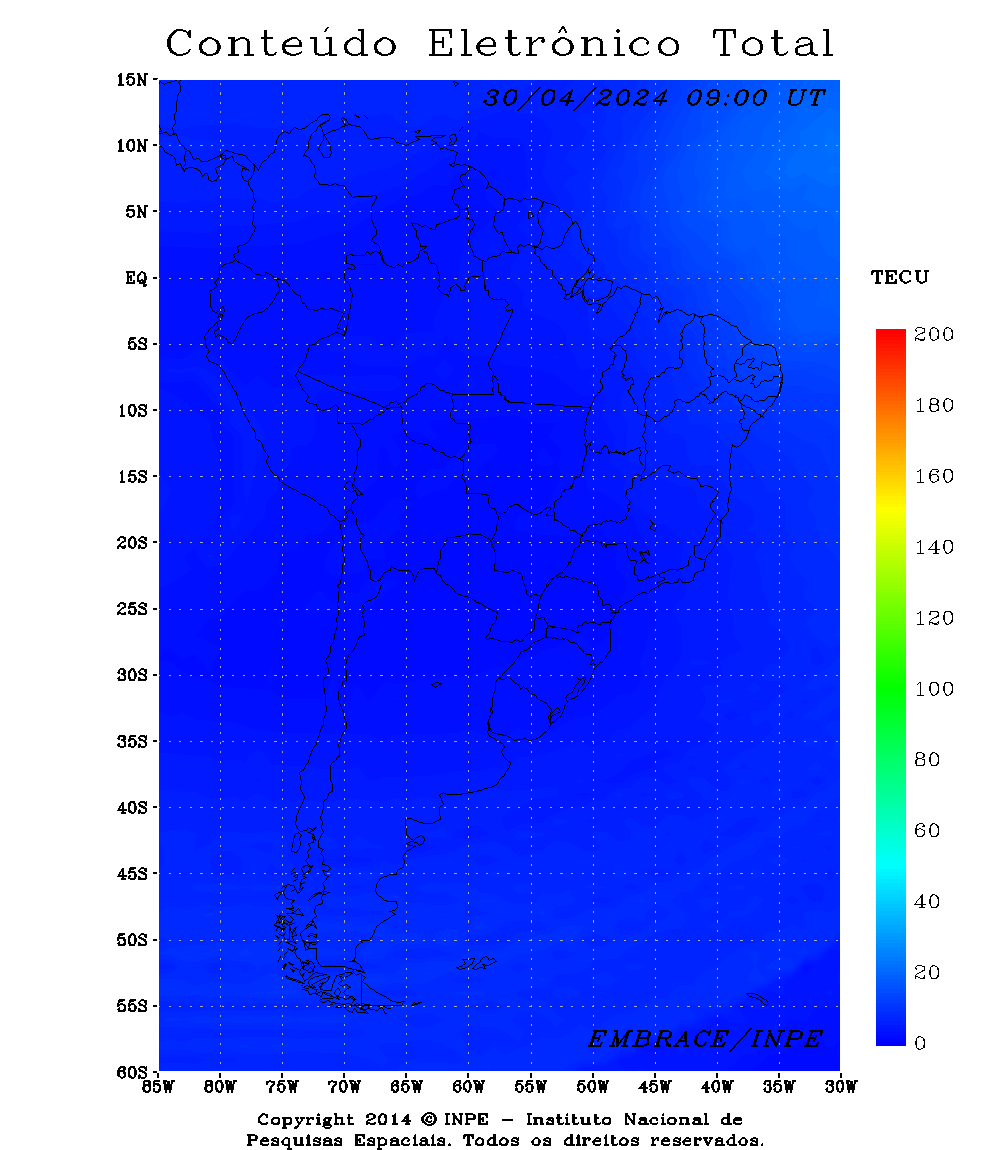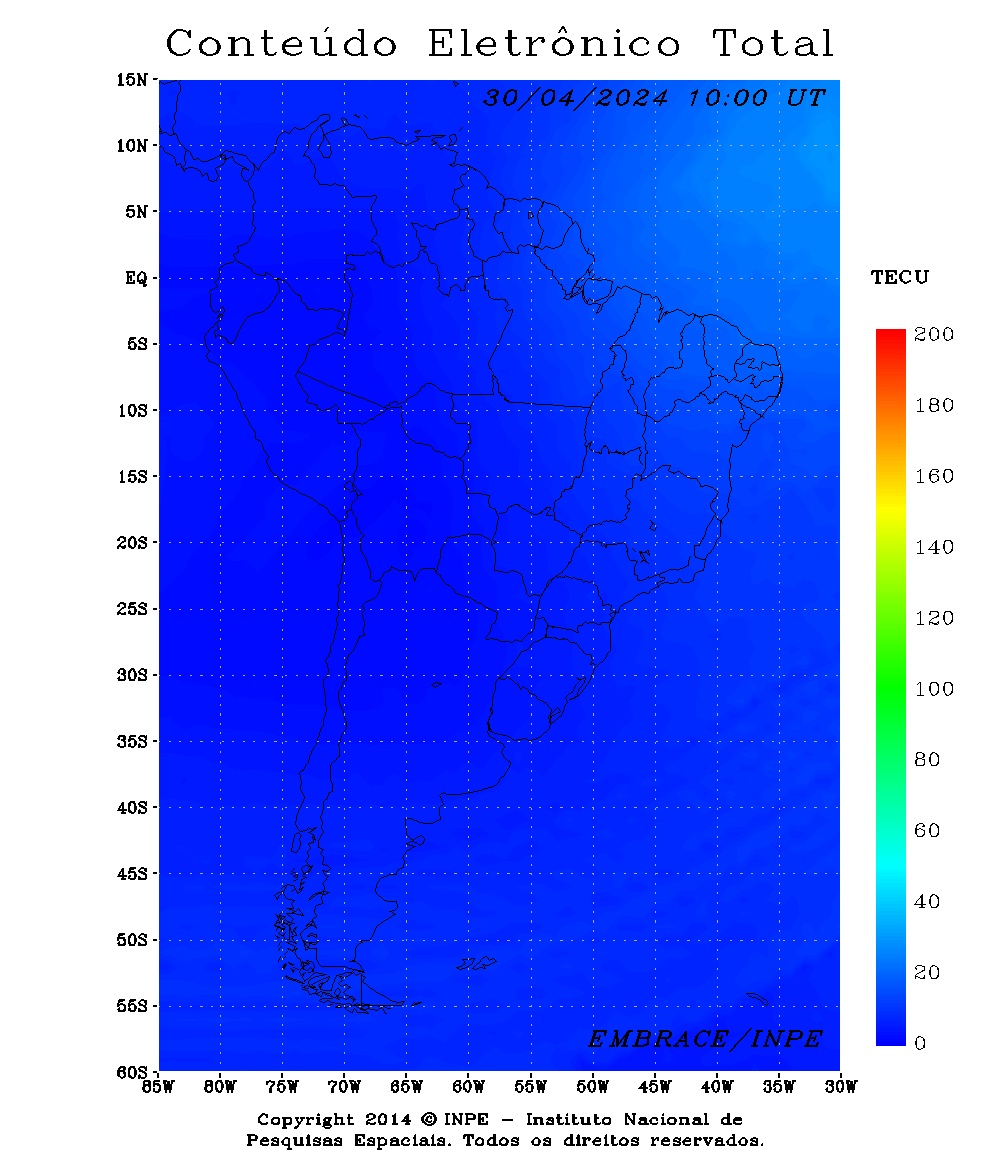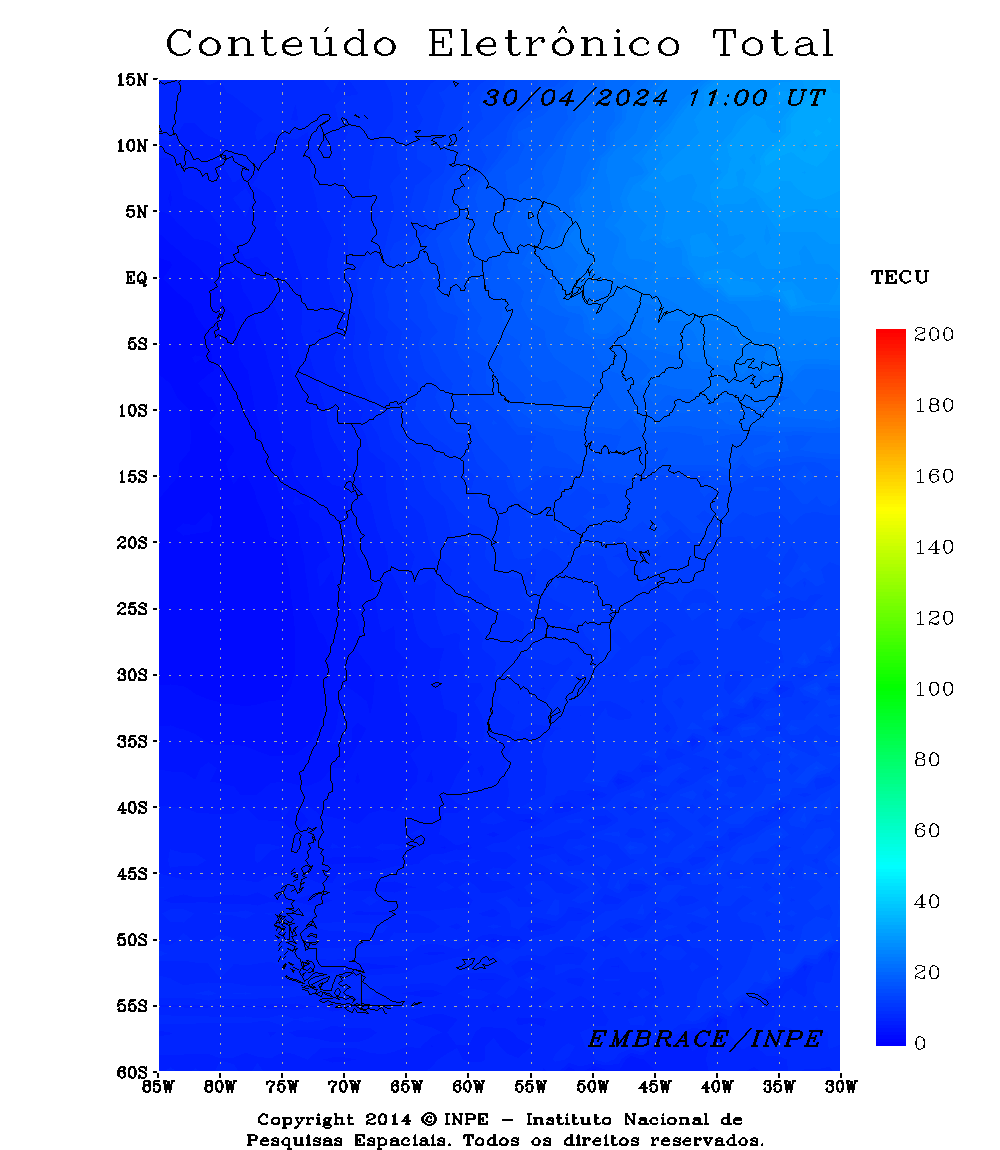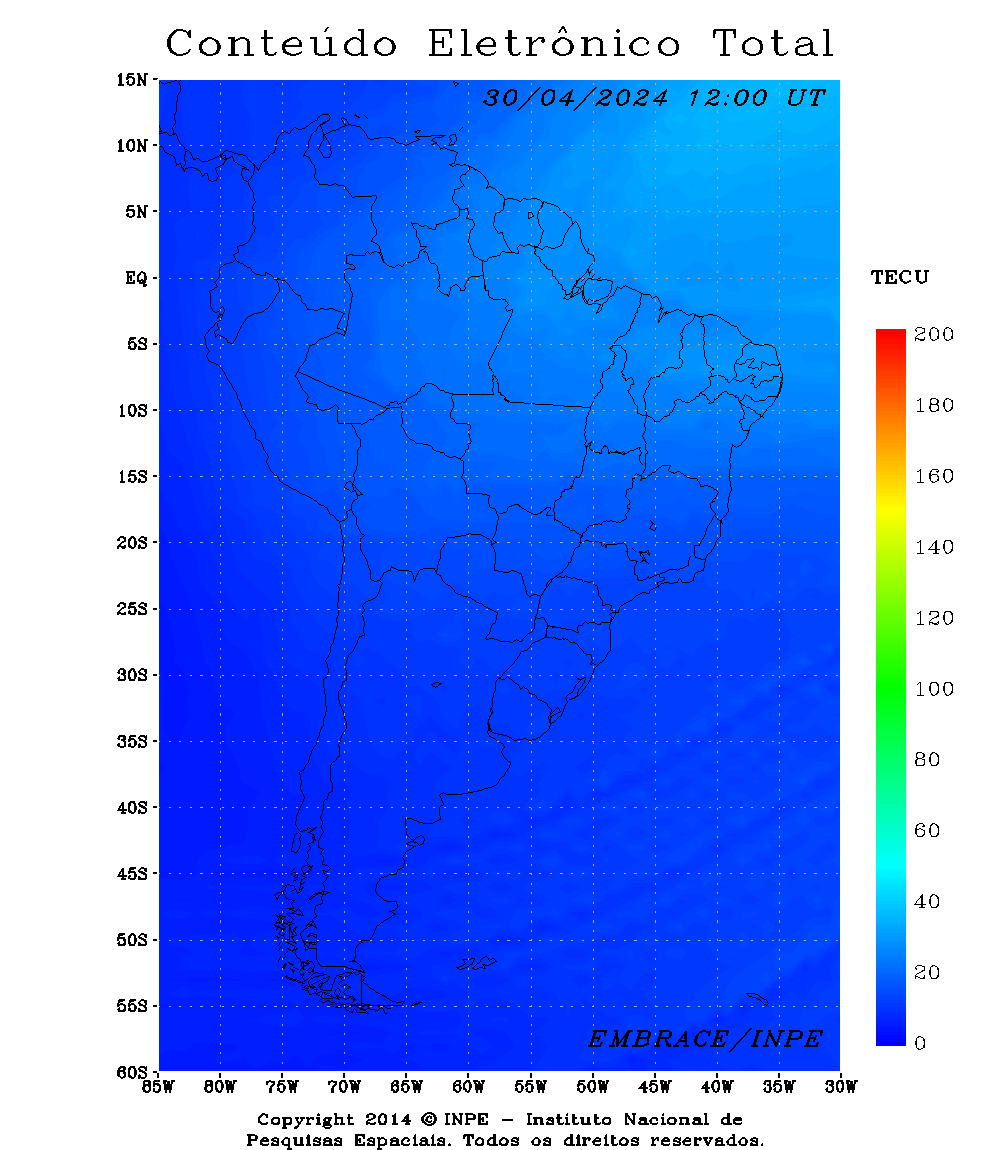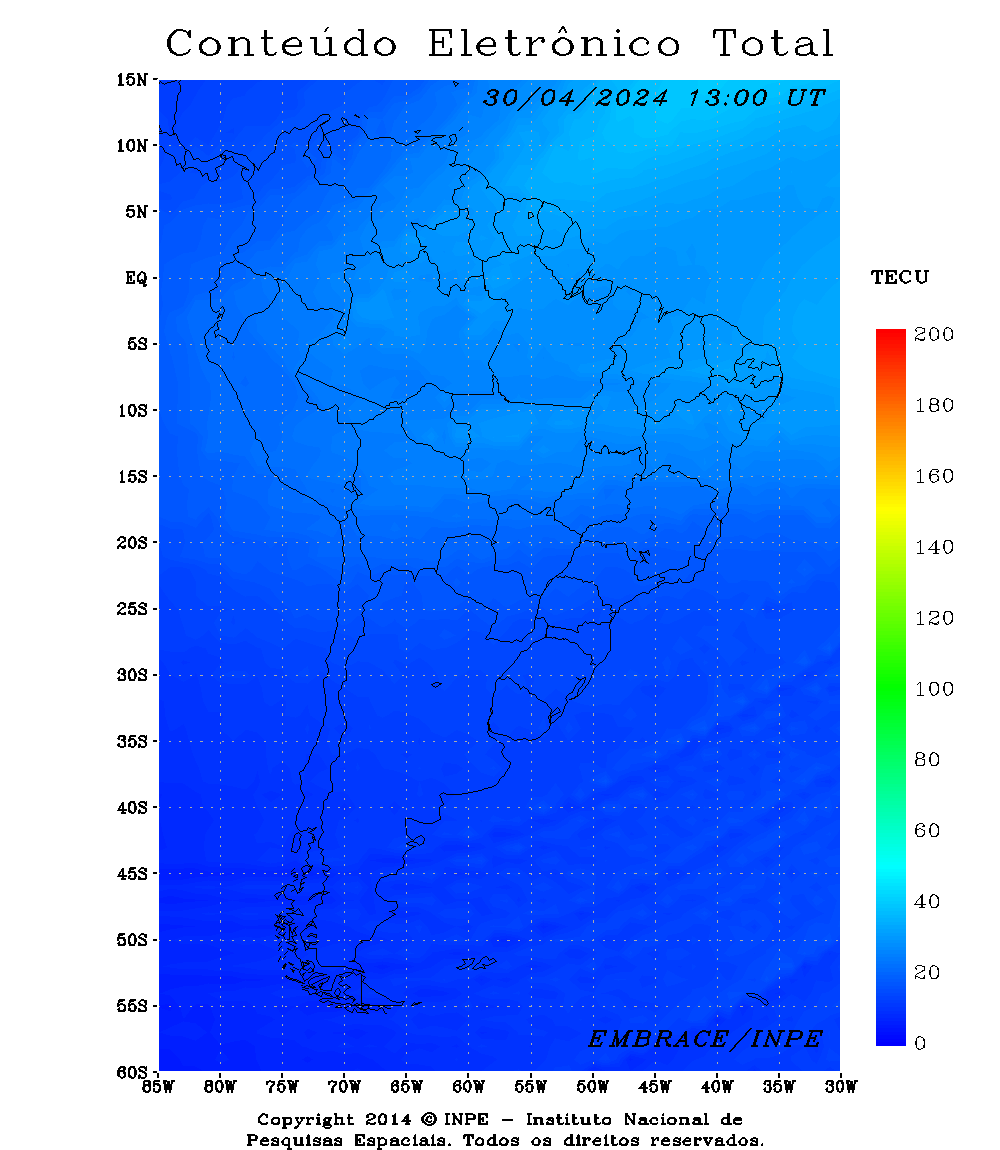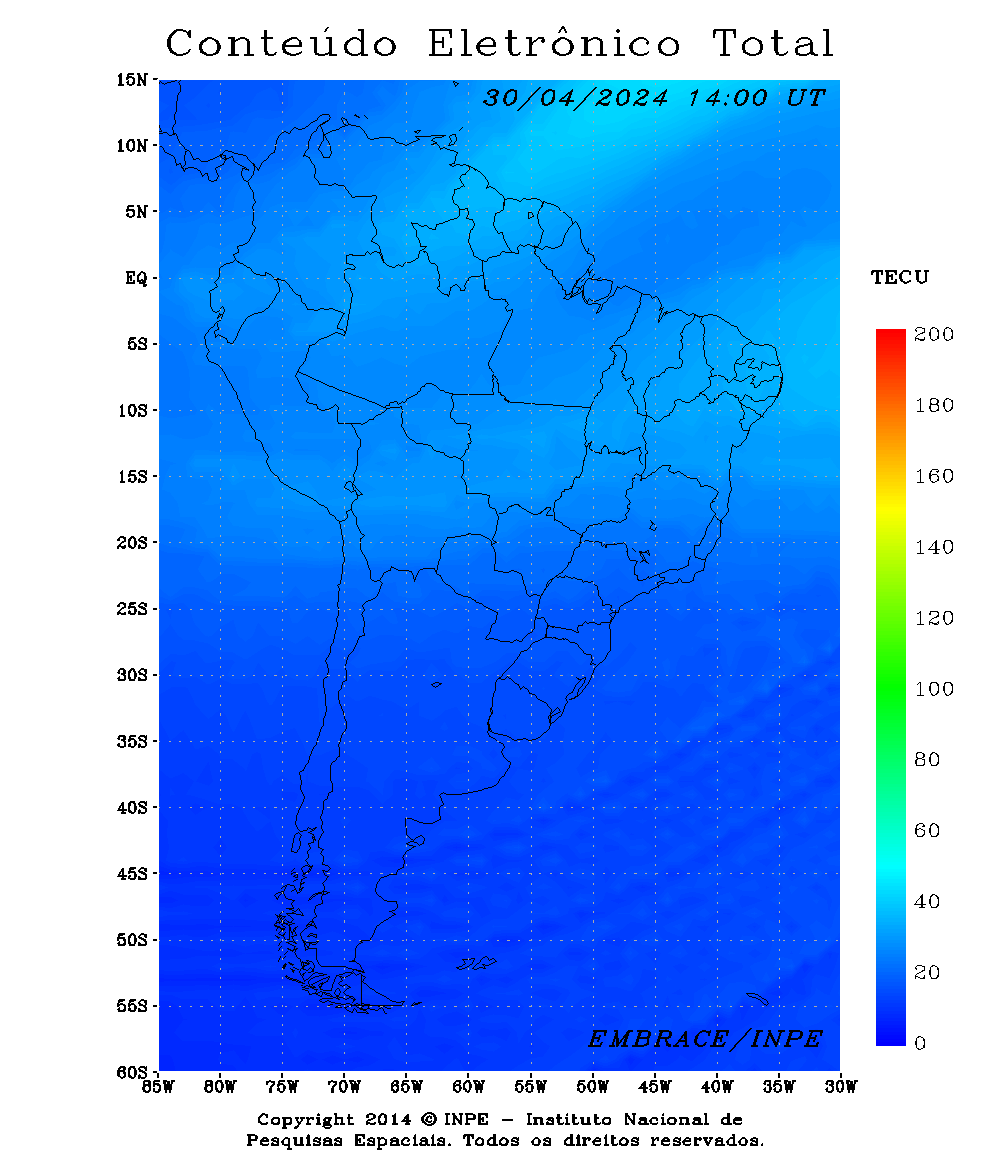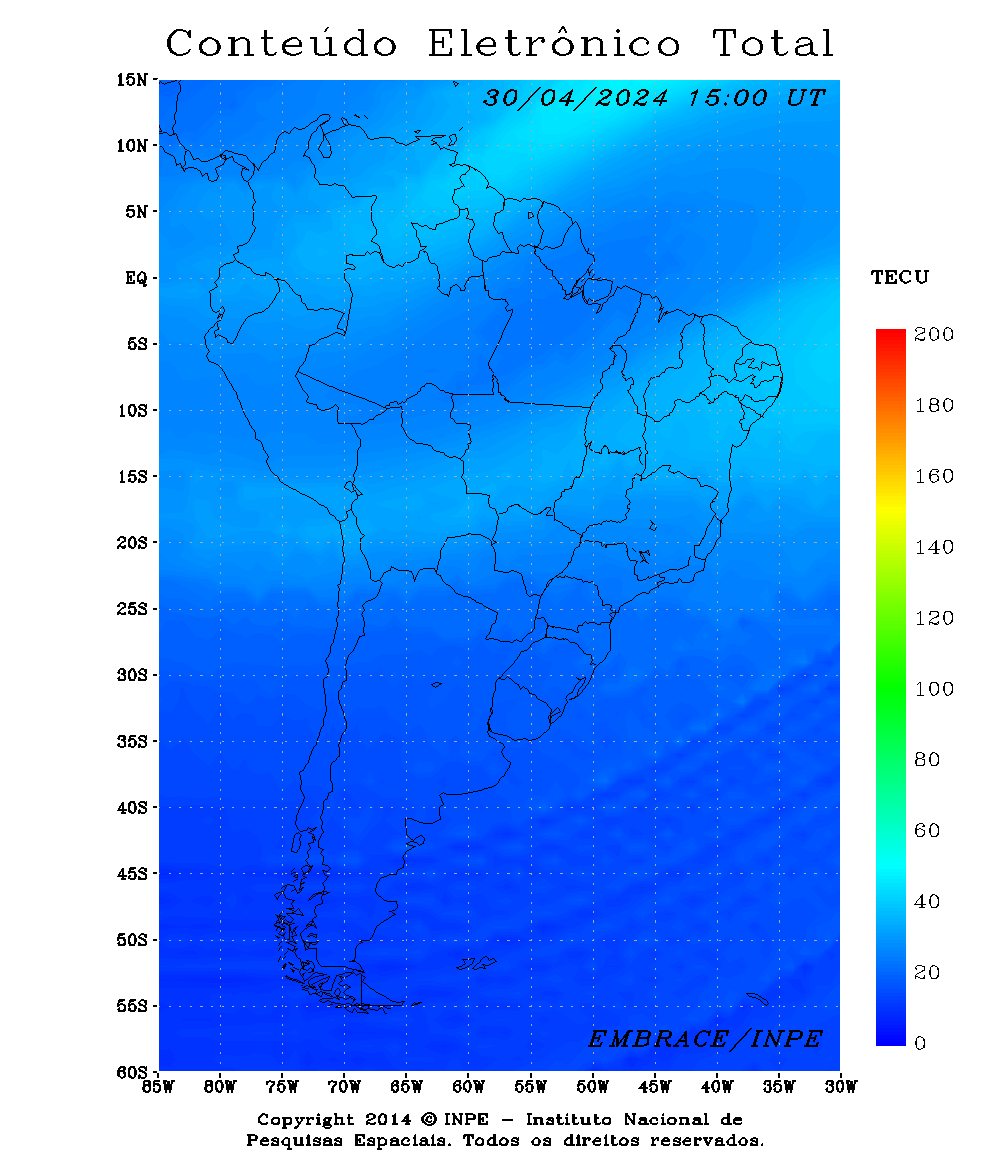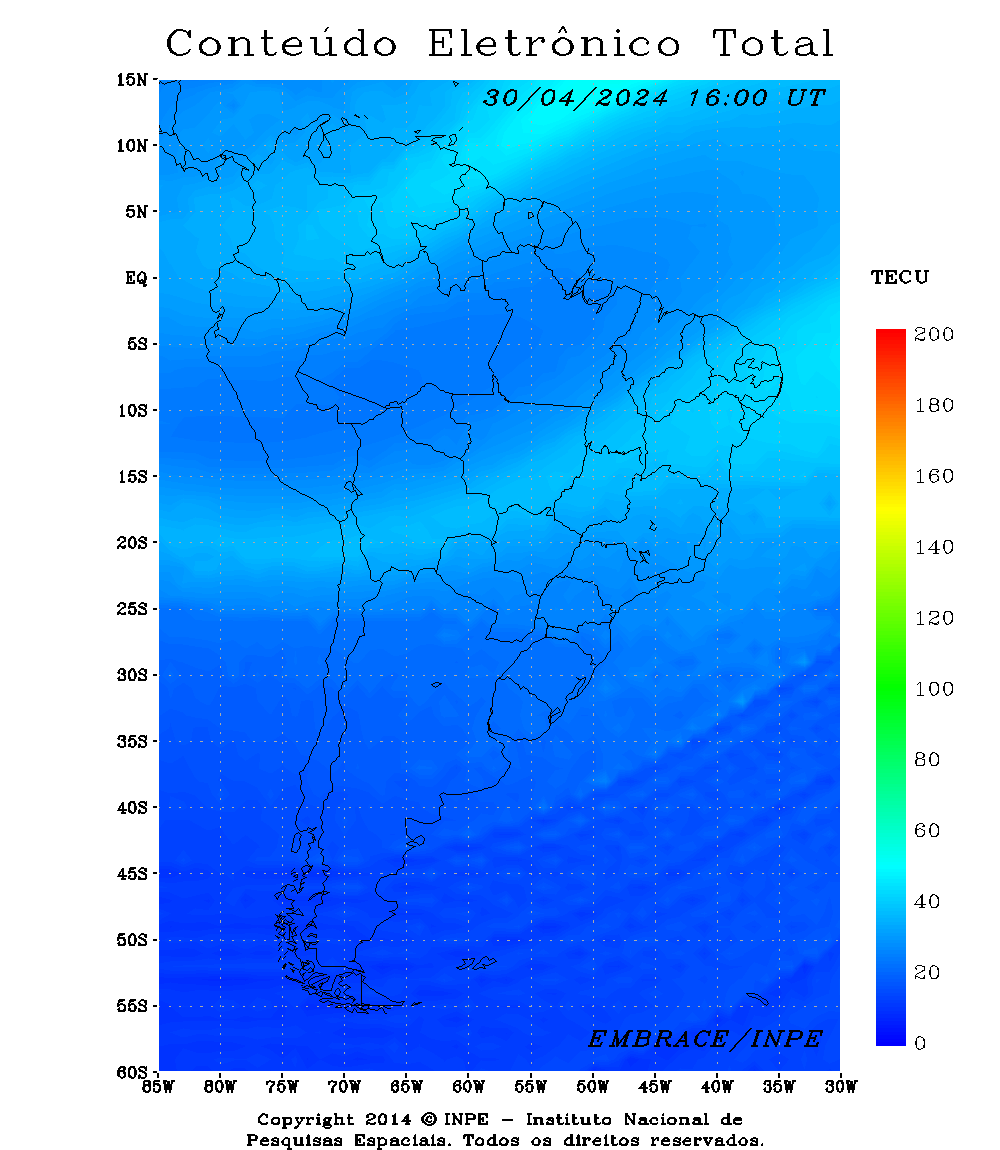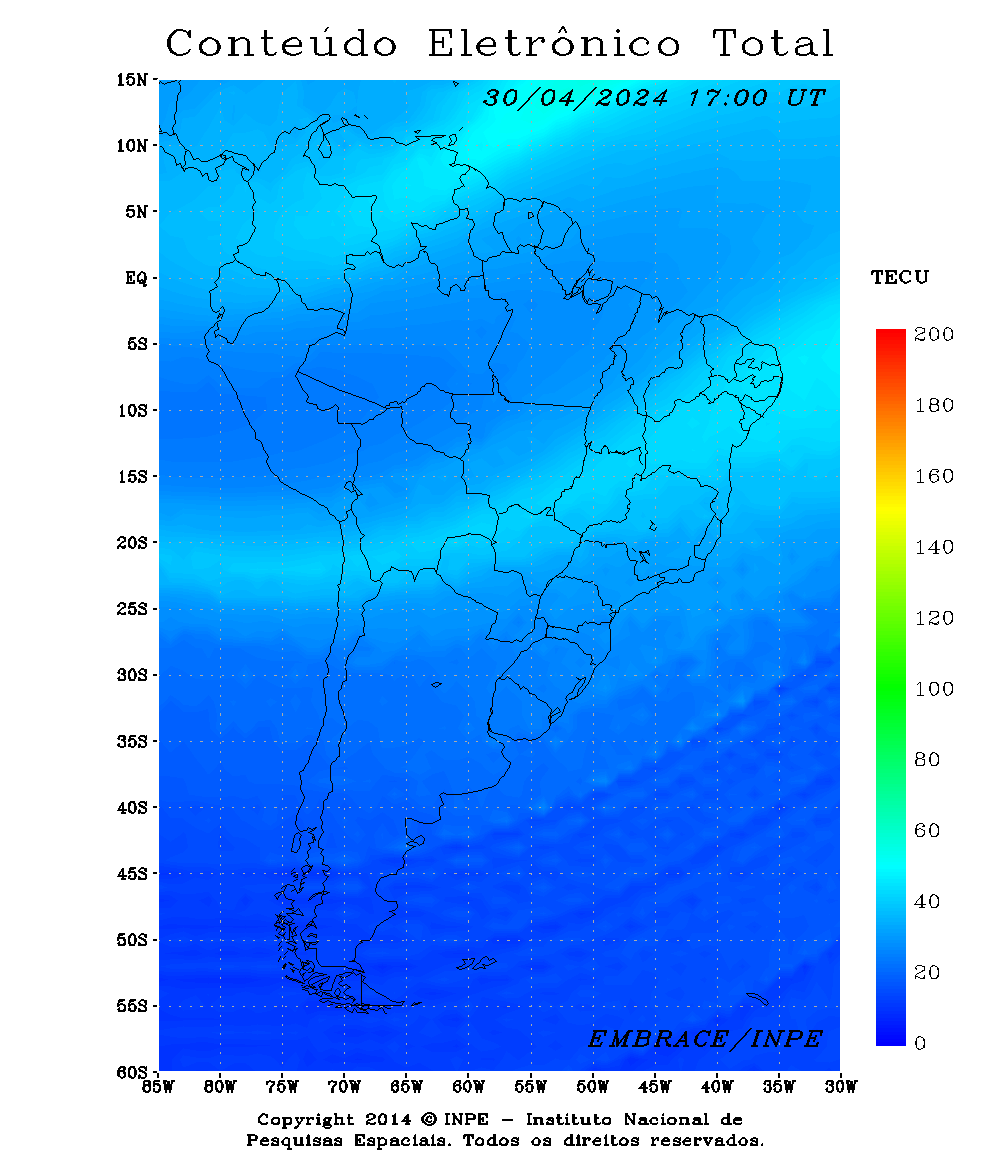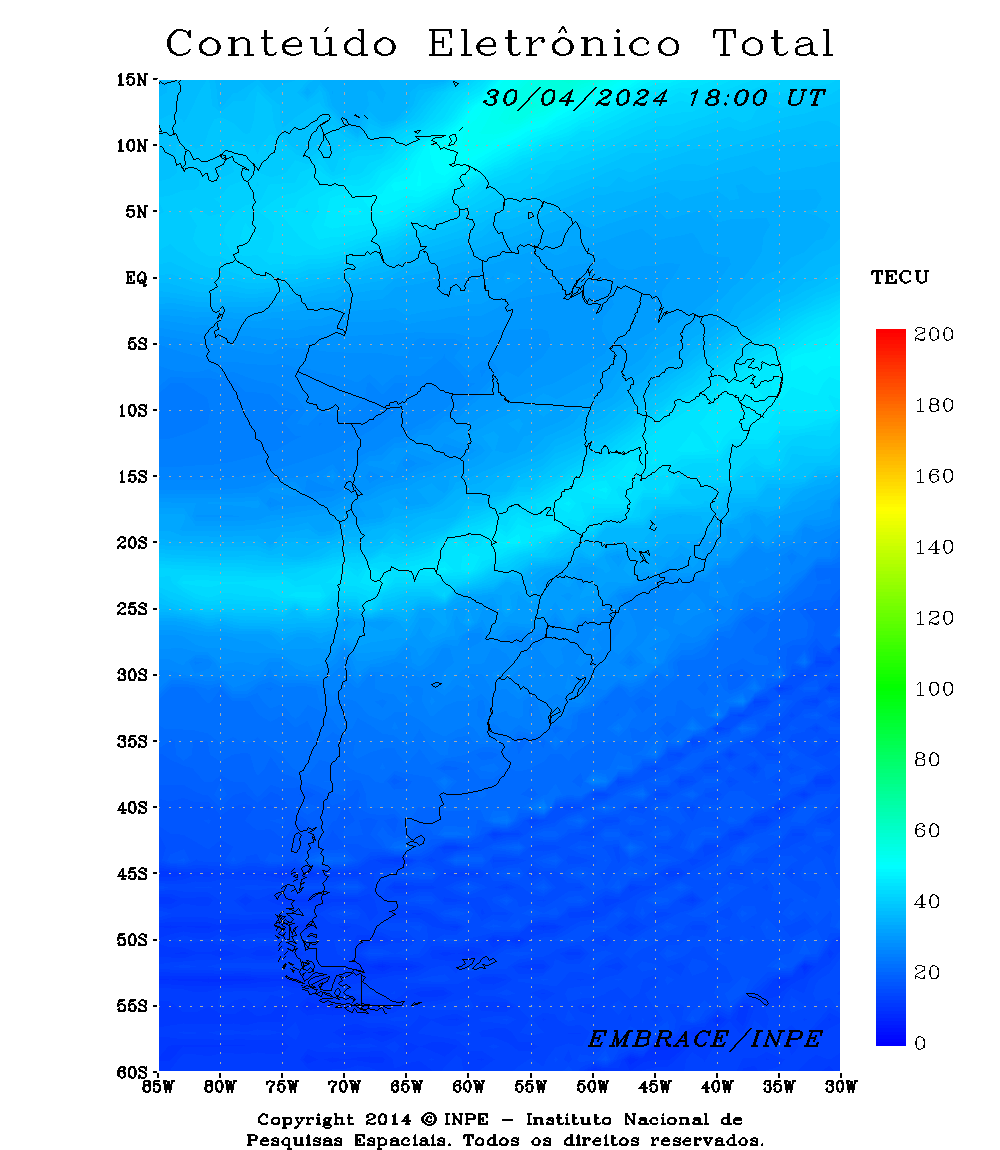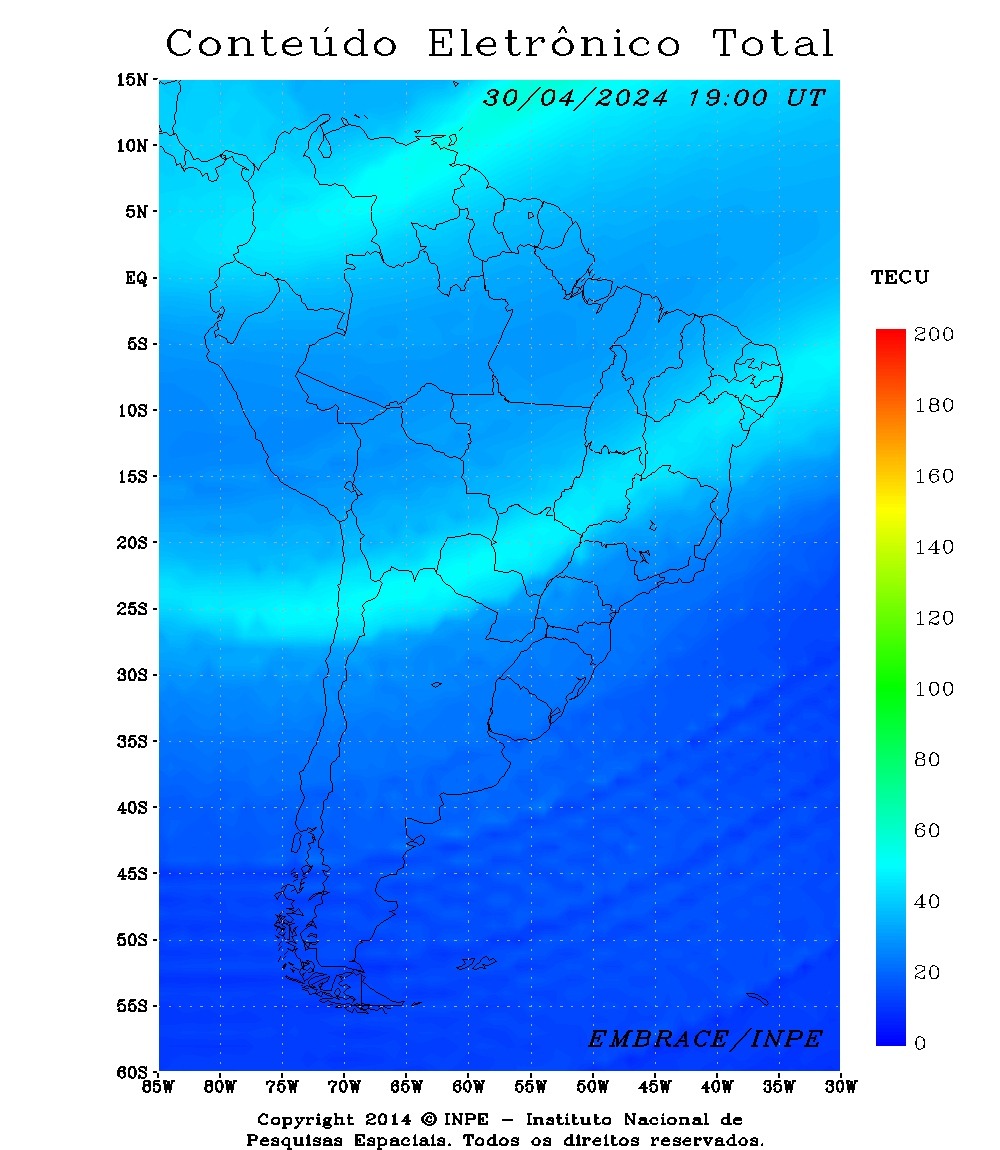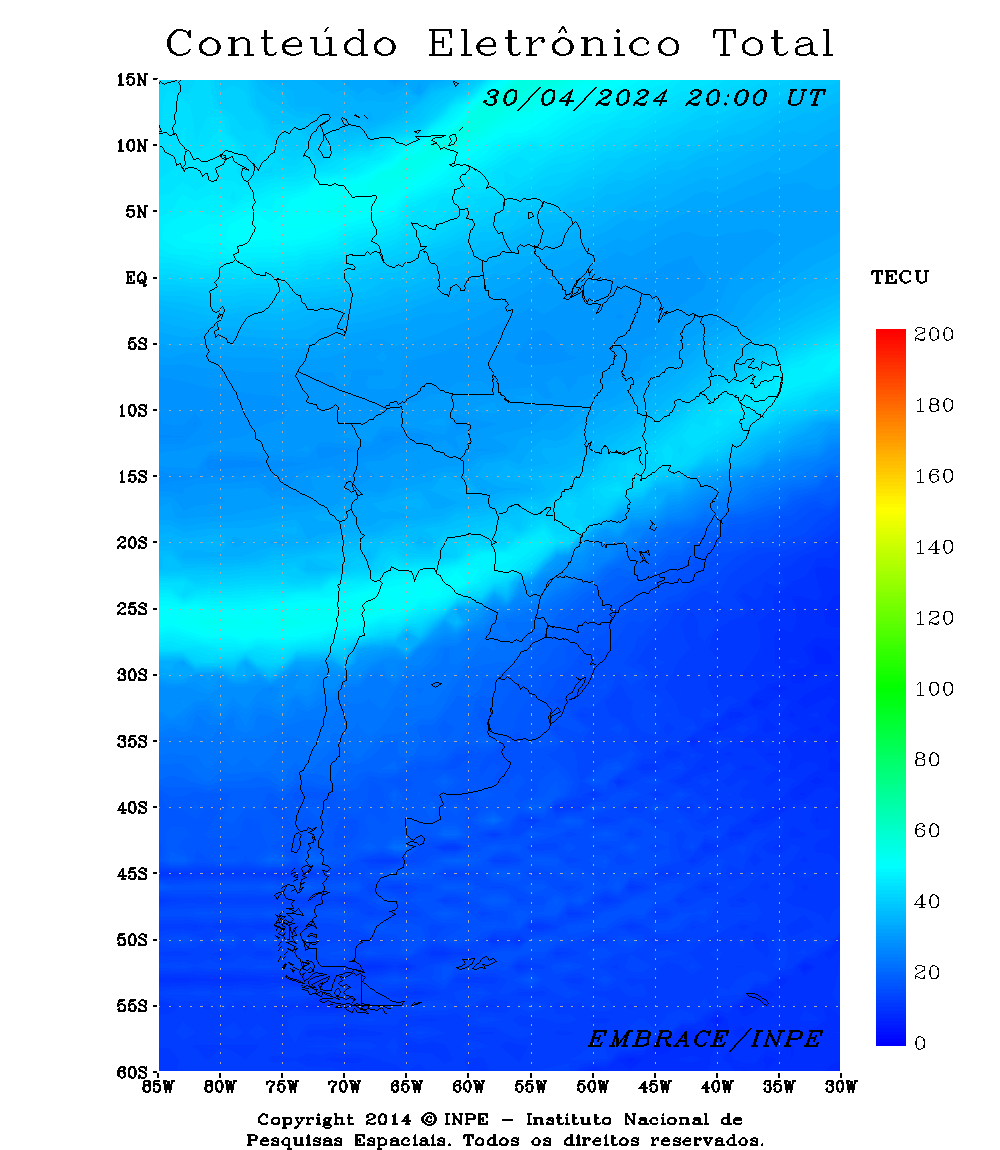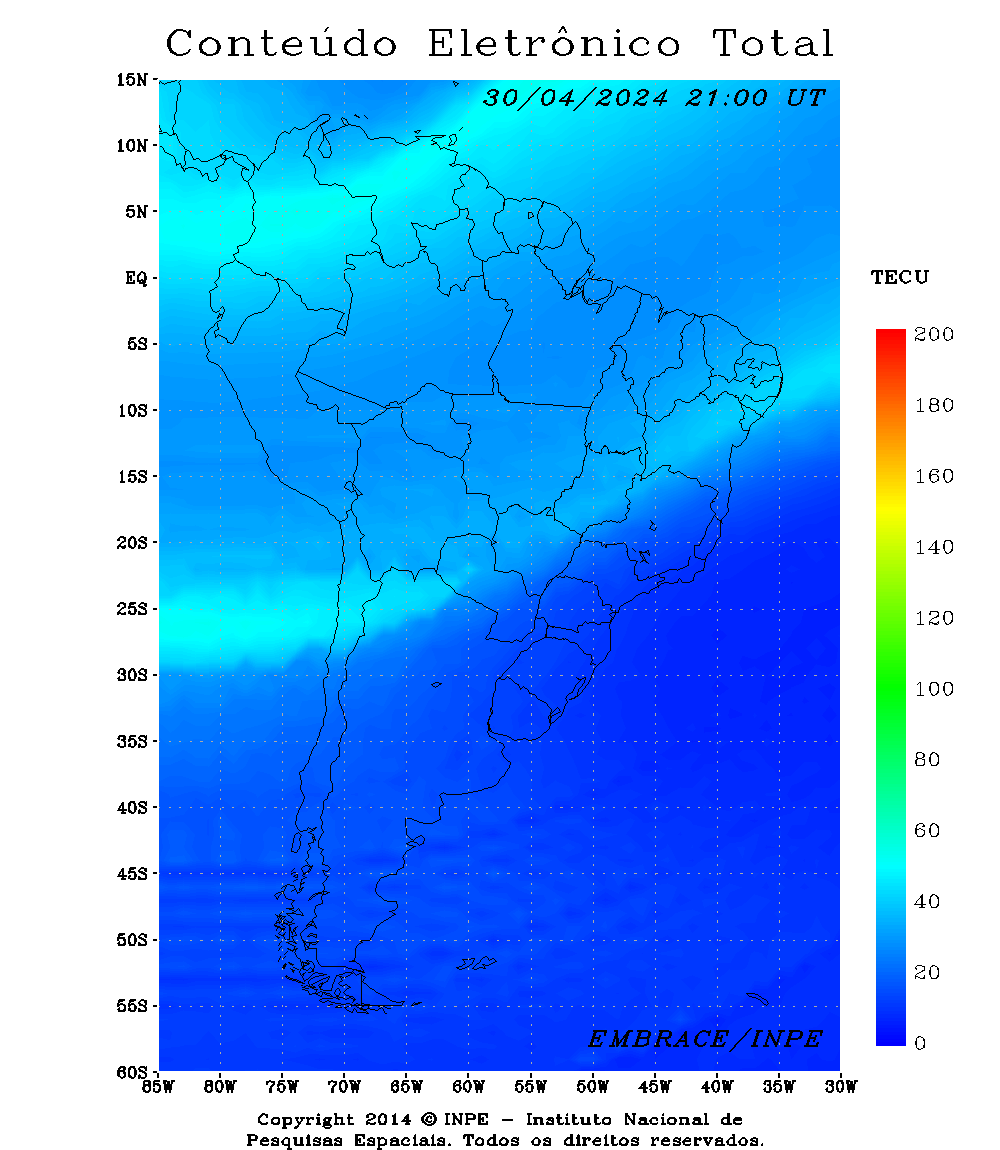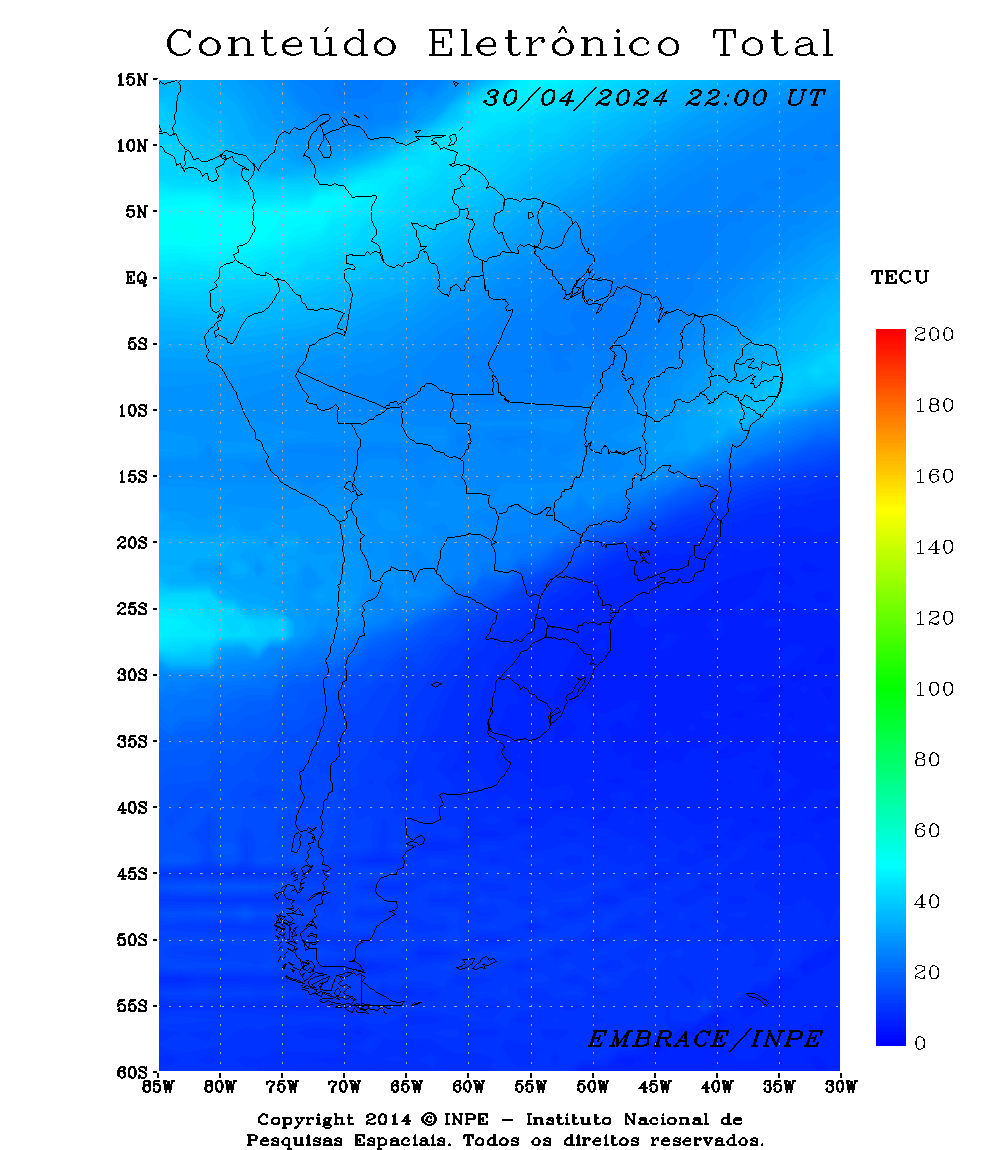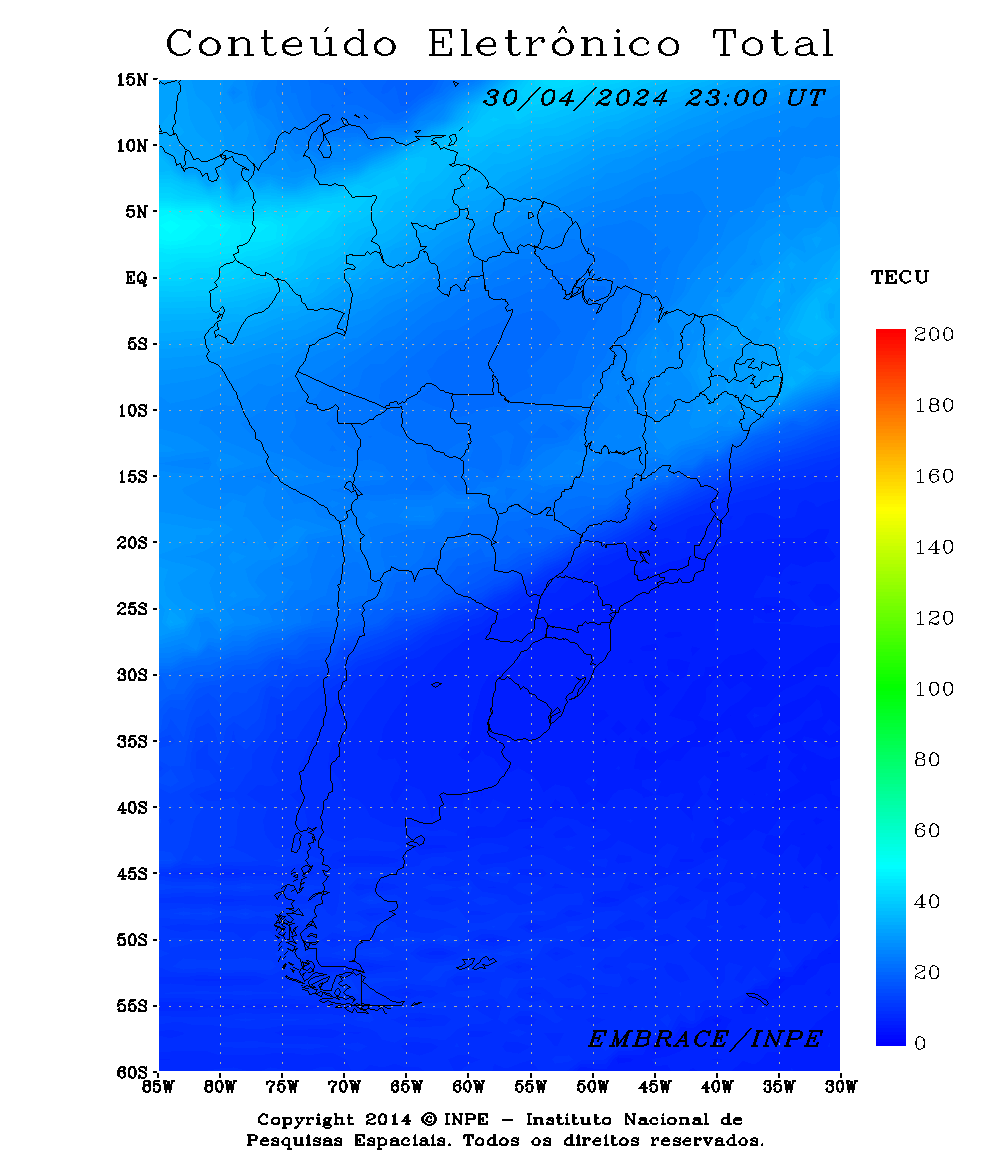SUPIM-INPE / Sheffield University Plasmasphere-Ionosphere Model no INPE
SUPIM is a first principles model of the ionosphere and plasmasphere of the Earth that has been developed over the past three decades [Sellek and Bailey, 1990, Bailey et al., 1993, Bailey and Balan, 1996, Souza et al., 2000 ; Santos, 2005, Souza et al., 2010, Souza et al., 2011].
In the model, the equations of continuity, motion and energy balance, both time dependent and coupled, are solved along the magnetic field lines closed to calculate the values ??of density, flow and temperatures of electrons and ions O +, H + , He + + N2, O2 + and IN +. SUPIM includes a more accurate representations of the Earth’s magnetic field which is an eccentric dipole. In fact, the magnetic field is obtained by displacing a dipole from the center of the Earth by a distance of 500 km in the direction of 21oN, 147oE and the axis cutting the surface of the Earth around 82oN, 90oW and 75oS, 119oE [Fraser -Smith, 1987].
The eccentricity of course, makes the magnetic coordinate system be different geographical area. The model includes numerous physical and chemical processes. The main ones are: production of ions due to solar EUV radiation, production and losses of ions due to chemical reactions between the ionized and neutral constituents, and thermal ambipolar diffusions, ion-ion collisions and ion-neutral particle, thermospheric winds, electromagnetic drift (E x B), thermal conductivity, heating photoelectric frictional heat and a large number of local heating and cooling mechanisms [Bailey et al., 1997].
Brief History of SUPIM at INPE/Brazil
The Aeronomy Division – CEA / INPE has maintained collaboration with Professor Bailey, Department of Applied Mathematics and Computer Science, University of Sheffield – UK for several years. Professor Bailey visited the INPE for the first time in 1990. This was the beginning of one of the most healthy and friendly cooperation of our division. In 1993, Dr. Eurico Rodrigues de Paula contacted Professor Bailey and got his permission to use the template code in SUPIM doctoral work developed by Jonas Rodrigues de Souza, then a student at the Graduate Program in the Space Geophysics INPE. This thesis, entitled ‘Ionospheric Modeling at Low Latitudes in Brazil’, was chaired by Dr. Ali Abdu Mangalathayil and Dr. Inez Batista Staciarini (Souza, 1997). Advances in understanding the code maximum SUPIM ocoreram between 1997-1999 during the post-doctoral research of Dr. Spencer at the University of Sheffield. Another important step was taken by doctoral work of Morais Pedrina Land of the Saints (Santos, 2005) . In 2002, Pedrina developed part of his doctoral work at the University of Sheffield, also supervised by Professor Bailey. This included an extension of SUPIM to perform calculations for the ionospheric E region. She presented the results of this work at the Congress of the CEDAR (Coupling, Energetics and Dynamics of Atmospheric Regions) held in Santa Fe, USA, in 2005 (Santos et al., 2005) . She received an award for best presentation of works in the ionosphere.
With the beginning of the Space Weather Program at INPE, coordinated by Dr. Hisao Takahashi, SUPIM was again modified to provide CET. Relevant contributions have been given by Dr. Adriano Petry Center for Space Research of the South Regional – CRS / RAC / INPE and Dr. Haroldo de Campos Velho Laboratory for Computing and Applied Mathematics – INPE SUPIM the parallelization of the code to run in groups (clusters) of INPE’s computers to generate daily maps of CET in geographic coordinates (Petry, A., 2010).
Thanks
INPE’s researchers who work with SUPIM acknowledge the financial support given by the National Council for Scientific and Technological Development – CNPq (Proc.: 201527/93.1) and the Research Foundation of the State of Sao Paulo – FAPESP (Procs.: 98 / 12245-6, and 00/05089-0 04/09432-1). Dr. Jonas R. Souza, Cida R. Souza and M. Pedrina T. Saints are grateful to Professor Bailey and his lovely wife Dorothy Bailey (in memory) by the loving hospitality and friendship during visits to the University of Sheffield.
References
Bailey, G.J., and R. Sellek, A mathematical model of the Earth’s plasmasphere and its application in a study of He+ at L=3, Ann. Geophysicae., 8, 171-190, 1990.
Bailey, G.J., R. Sellek, and Y. Rippeth, A modelling study of the equatorial topside ionosphere, Ann. Geophysicae, 11, 263-272, 1993.
Bailey, G.J., and N. Balan, A low-latitude ionosphere-plasmasphere model, STEP Handbook on Ionospheric Models, ed.R.W. Schunk, Utah State University, 173-206, 1996.
Bailey, G.J., Y.Z. Su, and N. Balan, The Sheffield University plasmasphere ionosphere model – a review, J. Atmos. Terr. Phys., 59, 1541-1552, 1997.
Drob, D. P, J. T. Emmert, G. Crowley, J. M. Picone, et al., An empirical model of the Earth’s horizontal wind fields: HWM07, J. Geophy. Res., doi:10.1029/2008JA013668, 2008.
Fraser-Smith, A.C. Centered and eccentric geomagnetic dipoles and their poles, 1600-1985, Rev. Geophys., 25, pp. 1-16, 1987.
Huba, J.D., Joyce, G., Fedder, J.A. Sami2 is another model of the ionosphere (SAMI2): a new low-latitude ionosphere model. J. Geophys. Res. 105 (A10), 23035–23053, 2000.
Petry, A. Análise e paralelização do código SUPIM. São José dos Campos: INPE, 2010. 35 p. (sid.inpe.br/mtc-m19@80/2010/07.19.13.43-NTC). Disponível em: http://urlib.net/8JMKD3MGP7W/37SMSTS.
Picone, J.M., Hedin, A.E., Drob, D., Aikin, A.C. NRLMSISE-00 empirical model of the atmosphere: statistical comparisons and scientific issues. J. Geophys. Res. 107 (A12), A1468, doi:10.1029/2002JA009430, 2002.
Santos, P.M.T., Estudo da Dinâmica do Sistema Ionosfera-Termosfera por Modelo Teórico e Observações Experimentais. São José dos Campos, SP, Instituto Nacional de Pesquisas Espaciais (INPE), 2005. (INPE-13270-TDI/1032).
Santos, P.M.T., J.R. Souza, J.H.A. Sobral, G.J. Bailey, C.G.M. Brum, Development of the Sheffield University Plasmasphere Ionosphere Model-Enhanced (SUPIM-E). In: 2005 CEDAR-GEM Joint Workshop, 2005, Santa Fe. 2005 CEDAR-GEM Joint Workshop, 2005.
Scherliess, L., B.G. Fejer, Radar and satellite global equatorial F region vertical drift model. J. Geophys. Res. 104, 6829–6842, 1999.
Souza, J.R. Modelagem ionosférica em baixas latitudes no Brasil. São José dos Campos, SP, Instituto Nacional de Pesquisas Espaciais (INPE), 1997. (INPE-6395-TDI/611).
Souza, J.R., M.A. Abdu, I.S. Batista, and G.J. Bailey, Determination of vertical plasma drift and meridional wind using the Sheffield University Plasmasphere ionosphere Model and ionospheric data at equatorial and low latitudes in Brazil: summer solar minimum and maximum conditions, J. Geophys. Res., 105, 12,813-12,821, 2000.
Souza, J.R., C.G.M. Brum, M.A. Abdu, I.S. Batista, W.D. Asevedo Junior, G.J. Bailey, J.A. Bittencourt. Parameterized regional ionospheric model and a comparison of its results with experimental data and IRI representations. Advances in Space Research, v. 46, p. 1032-1038, 2010.
Souza, J.R., P.M.T. Santos, G.J. Bailey, M.A. Abdu, I.S. Batista, Enhancement of the Sheffield University plasmasphere-ionosphere model: E region and new inputs. To be submitted to JGR, 2011.
Strobel, D.F., Young, T.R. The nighttime ionosphere: E region and lower F region. J. Geophys. Res. 79 (22), 3171–3178, 1974.
Tobiska, W.K., Woods, T., Eparvier, F., Viereck, R., Flyod, L., Bouwer, D., Rottman, G., White, O.R. The SOLAR2000 empirical solar irradiance model and forecast tool. J. Atmos. Terr. Phys. 62, 1233–1250, 2000.





